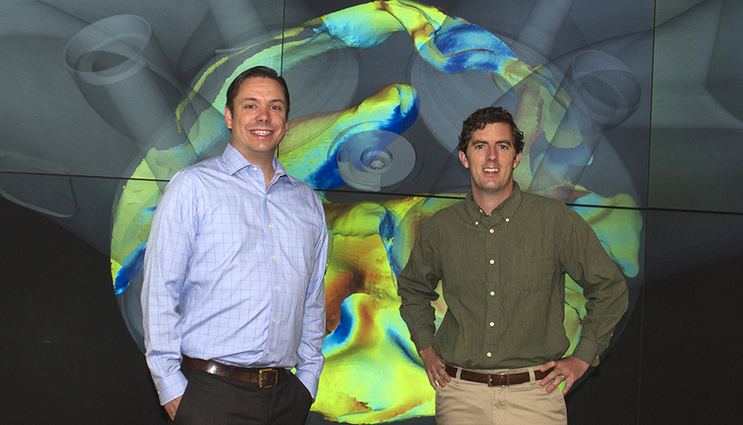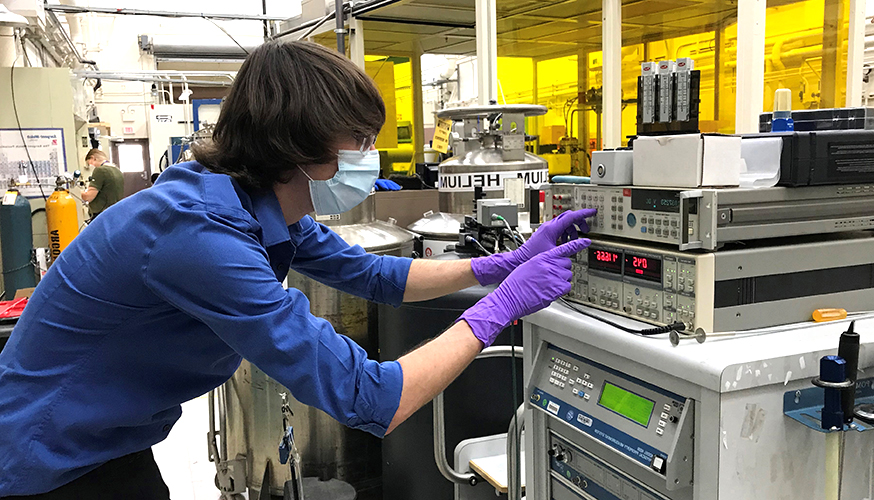Lab garners five commercialization grants
 (Download Image)
(Download Image)
Behind computational scientist Matthew McNenly and mechanical engineer Russell Whitesides, the video wall shows a snapshot of an engine simulation with the flame front colored by the local velocity. Zero-order Reaction Kinetics (Zero-RK) enables engine designers to use more accurate chemical models in these simulations to better predict engine performance, including critical phenomena like auto-ignition (or knock) and emissions formation (for example, soot and nitrogen oxides). Photo by Julie Russell/LLNL.
Lawrence Livermore National Laboratory (LLNL) scientists and engineers have put together another first-rate year securing major grants through the Department of Energy’s (DOE) Technology Commercialization Fund (TCF).
“We did quite well, although the diversity of the research projects funded wasn’t as broad as last year,” said Rich Rankin, the director of the Lab’s Innovation and Partnerships Office (IPO).
“We received funding for several projects that will provide the support they need to increase their commercial potential; these are really excellent projects and we’re pleased about them.”
Two of the projects are related to combustion, two focus on advanced alloys and one deals with development work to provide upgraded nuclear radiation shielding.
This year’s TCF program will provide LLNL researchers with about $2.2 million, with about $1.1 million from DOE and some $1.1 million in matching funds from the Lab’s IPO and from industrial partners.
Under the TCF program, DOE national lab scientists and engineers can apply for two types of awards. The first (Topic 1) is focused on early stage technologies and in fiscal year 2020 provided between $100,000 to $250,000 for work to be carried out over six-18 months.
The second (Topic 2) award provided funds from $250,000 to $1.5 million for a 12-36 month period of work. Although both award types encourage collaborative work with industry partners, support from an industry partner is necessary for Topic 2. Both award types are required to provide a 50 percent cost share, either cash or in kind from non-federal sources.
In the grant awards announced by DOE earlier this year, LLNL secured four Topic 1 awards and one Topic 2 award that include collaborations with seven different industry partners.
LLNL materials physicist Alex Baker inspects signal levels as he prepares a measurement on a permanent magnet produced by a new processing method. Photo by Scott McCall/LLNL
Advanced shielding for nuclear energy uses
Three LLNL researchers will be working with Escondido, California-based American Ceramic Technology and Ames Laboratory to produce upgraded magnetically adhesive radiation shielding.
The new shielding would substitute manganese-bismuth magnets for rare earth magnets. Previously, the manganese-bismuth magnets lacked the magnetic strength required for radiation shielding, but new synthesis and fabrication processes developed at LLNL and Ames have overcome this limitation.
There is a drive to replace lead shielding with more advanced engineered materials and this high-performance magnet radiation shielding is an enabling technology to enhance safety at nuclear power plants and related industries.
The team, led by Scott McCall, a materials physicist in the Materials Science Division of the Physical and Life Sciences (PLS) Directorate, will work under a one-year, $240,000 Topic 1 award in collaboration with American Ceramic Technology and Ames Laboratory.
Using chemical kinetics for combustion simulations
LLNL researchers have developed a software package called Zero-order Reaction Kinetics (Zero-RK) that is thousands of times faster simulating large chemically reacting systems compared to state-of-the-art commercially available solvers.
A team of four Lab researchers will work with two industrial partners, Westmont, Illinois-based Gamma Technologies, makers of GT-SUITE, and Madison, Wisconsin-based Convergent Science Inc., makers of CONVERGE, to create interfaces to allow Zero-RK to accelerate the chemistry simulations in their software tools.
Gamma Technologies’ GT-SUITE and Convergent Science’s CONVERGE are used by the majority of the U.S. engine manufacturing industry to model engine performance. Zero-RK can reduce the time it takes to run engine combustion simulations from weeks to days.
A tenfold reduction in chemistry solution time could reasonably result in a fivefold decrease in computer costs, providing millions of dollars in savings for larger automotive design companies, such as General Motors and Ford.
Led by Russell Whitesides, a mechanical engineer in the Computational Engineering Division, the Lab team has garnered a two-year, $545,000 Topic 2 award with its two industrial partners.
Characterizing fuels using smaller amounts
LLNL researchers have developed a method to characterize the ignition quality of a fuel by using only microliter amounts of the fuel. Under a $100,000 Topic 1 award, the team will seek to advance their technology.
Currently, the ignition quality of automotive fuels for spark-ignited engines is quantified using octane ratings and typically requires a liter of fuel (about one-quarter of a gallon of gas) to measure the fuel performance rating.
Producing a liter of bio-derived fuels or additives is often prohibitive, as the techniques used for initial development typically produce small batches. The cost to produce a liter of some components is 1,000 times greater than running the engine test for the octane rating.
This technology will permit small and large companies, as well as academic and government researchers, to quickly and cheaply explore the vast number of promising molecules that can be used in transportation fuels.
Work on the project is headed by principal investigator Nick Killingsworth, a mechanical engineer in the LLNL’s Computational Engineering Division.
Designing alloys for additive manufacturing
Two LLNL researchers have started developing advanced computational thermodynamic methods and tools to understand and solve process-related additive manufacturing problems, such as anisotropic properties and hot cracking.
As additive manufacturing (AM) has moved from a prototyping tool to a transformative technology, it has been appealing because of the ability to rapidly fabricate complex geometries and reduce the number of parts.
However, most conventional alloys are poorly suited for AM uses because of problems like columnar growth and residual stress. Thus, new AM-tailored alloys are needed to support printability and maintain the material properties for the final product.
The researchers, led by Lab materials scientist Aurélien Perron, are seeking to develop a user-friendly, easy-to-commercialize tool to identify potential novel alloys with customized features for use in AM.
The team is working under a $250,000 Topic 1 award and is collaborating with Cloverdale, California-based MolyWorks.
Converting carbon dioxide to fuel
A team of LLNL scientists is working on ways to electrochemically convert carbon dioxide from an industrial waste product to high-demand chemicals and transportation fuels.
The targeted chemicals that would be produced include ethylene, a feedstock material for polymers; ethanol and methane that are all needed to feed industrial chemical process lines and power vehicles.
The electrochemical conversion of carbon dioxide also provides a pathway for high-volume, seasonal storage of renewable energy by transforming intermittent renewable electric energy, such as solar and wind, into chemical energy.
The LLNL team, led by materials scientist Juergen Biener, is working with Berkeley-based Opus 12, a startup company, to improve the activity, selectivity and long-term stability of the electrocatalyst as one critical part of a system to convert carbon dioxide to chemicals at an industrial scale. The team is funded under a $250,000 DOE Topic 1 award and also is collaborating with TOTAL American Services, in addition to Opus 12.
Contact
 Stephen Wampler
Stephen Wampler
[email protected]
(925) 423-3107
Related Links
“Lab wins six tech commercialization grants,” July 29, 2019Tags
Advanced Materials and ManufacturingAdditive manufacturing
Materials Science
HPC, Simulation, and Data Science
Computing
Physical and Life Sciences
Industry Collaborations
Technology Transfer
Energy
Community Outreach
Featured Articles








